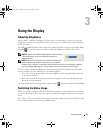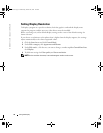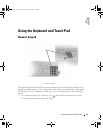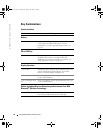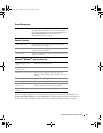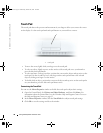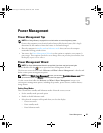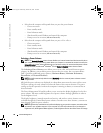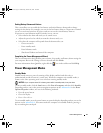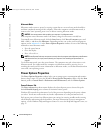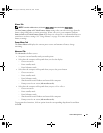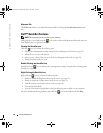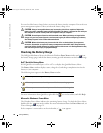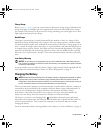
Power Management 41
Setting Battery Alarms and Actions
This screen allows you to enable the low-battery and critical-battery alarms and to change
settings for the alarms. For example, you can set the low-battery alarm to 20 percent to remind
you to save work and switch to AC power, and you can set the critical-battery alarm to
10 percent to enter hibernate mode. From the screen, you can:
• Select whether the alarm will notify you by sound or text.
• Adjust the power level at which you want the alarm to notify you.
• Select how the computer will respond when the alarm notifies you:
– Choose no action.
– Enter standby mode.
– Enter hibernate mode.
– Shut down Windows and turn off the computer.
Completing the Power Management Wizard
This screen summarizes the QuickSet power scheme, sleep mode, and battery alarm settings for
your computer. Review the settings you have selected and click Finish.
For more information about QuickSet, right-click the icon in the taskbar and click Help.
Power Management Modes
Standby Mode
Standby mode conserves power by turning off the display and the hard drive after a
predetermined period of inactivity (a time-out). When the computer exits standby mode, it
returns to the same operating state it was in before entering standby mode.
NOTICE: If your computer loses AC or battery power while in standby mode, it may lose data.
To enter standby mode, click the Start button, click Turn off computer, and then click Stand by.
Depending on how you set the power management options on the Advanced
tab
in the Power
Options Properties window, use one of the following methods:
• Press the power button.
• Close the display.
• Press <Fn><Esc>.
To exit standby mode, press the power button or open the display depending on how you set the
options on the Advanced
tab
. You cannot make the computer exit standby mode by pressing a
key or touching the touch pad.
book.book Page 41 Wednesday, October 26, 2005 1:00 PM



